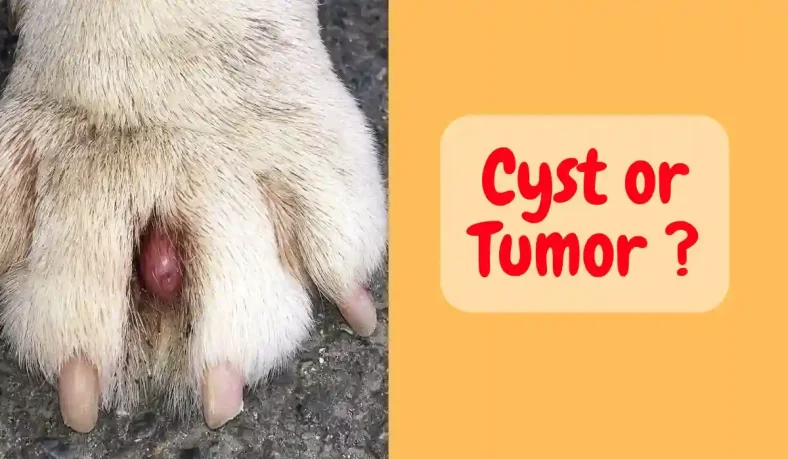Keeping tabs on the well-being of our beloved animal friends is one of the most important duties of any pet parent. Fortunately, understanding the distinctions between canine cysts and tumors can be simpler than it seems.
In this guide, let’s explore the chief contrast between these two health issues and provide helpful advice so that you know exactly what to look out for!
Contents
What are Dog Cysts?
Does your pup have a cyst? Don’t worry–it’s usually harmless, but it’s important to get it treated right away. There are various types of cysts that can form on your furry friend, like sebaceous or epithelial cysts. Take care of your pup and make sure you get them the best treatment!
The Causes of Dog Cysts
Knowing the genetic and hormonal factors that can contribute to cysts, as well as certain breeds being more prone to developing them, it’s essential to stay informed of any instances in your family. If you know what to look out for, you and your furry friend can be better prepared!
Symptoms of Dog Cysts
If any of the following appear – redness, swelling, or pain in the affected area – it is important to act fast and visit your vet!
Cysts are usually harmless and not uncomfortable, but if they become infected, prompt attention can make all the difference. Stay alert and take good care of your furry family members!
What are Dog Tumors?
Growths in our beloved furry friends can be a cause for concern. Tumors can appear in various forms, ranging from harmless and fatty to potentially hazardous mast cell tumors and osteosarcomas. Whenever you notice any unusual physical changes in your pup, it is always important to contact your vet for an examination.
The Causes of Dog Tumors
It’s unclear what exactly contributes to dog tumors, but some research points to a combination of genetics and environmental factors as possible culprits. Whatever the case may be, it’s important to look out for your pup’s health!
Symptoms of Dog Tumors:
If you notice any unusual changes in your pup’s well-being, it’s essential to get veterinary help quickly. These can often include the appearance of lumps or bumps, reduced bodyweight, and a disinterest in food. The precise symptoms are determined by the kind and position of the tumor. Be sure to stay alert for these warning signs!
How to Tell the Difference?
A cyst is usually a gentle, round and jelly-like bubble that can be moved around. Compared to this, a tumor tends to be harder and appears more immovable, with contours that are not perfectly smooth.
Got a feel like your pooch may have a cyst or tumor? Make sure to book an appointment with the vet ASAP. They’ll give them a physical and use special methods like X-rays, biopsies, or ultrasounds to determine what’s going on. Don’t wait—get your pup checked out today!
Can a Cyst on a Dog Turn into Cancer?
Don’t take any chances – if you notice a cyst or mass growing rapidly or giving your pet any kind of trouble, always have a vet check it out! Cysts typically aren’t dangerous, but in rare cases, they can become cancerous, so better safe than sorry!
Are Dog Tumors Hard or Soft?
The softness and hardness of tumors can differ based on their type and development. Some may feel spongy and squishy, while others are quite firm. Don’t hesitate to book an appointment right away.
When Should I Worry About a Cyst on my Dog?
If discomfort, accelerated growth, redness, swelling, or pain is observed around a cyst, seek veterinary assistance without delay.
What Does a False Cyst Look Like on a Dog?
False cysts, also known as pseudocysts, can be deceiving as they mimic the look of real cysts but do not actually contain any fluid. These growths can be caused by inflammation, injury, or infection and are sometimes mistaken for tumors. It’s essential to have any suspicious development thoroughly examined by a professional veterinarian.
Do Dog Cysts Go Away on Their Own?
Sometimes minor cysts can clear up on their own, but for bigger ones that cause distress or have become infected, it’s best to have a veterinarian drain or remove them surgically.
Why is My Dog Suddenly Getting Cysts?
It can be difficult to understand why cysts appear in our canine companions, as this problem can stem from a range of causes – from heredity, hormonal disruptions and infection. To gain clarity on the matter and find meaningful solutions, it’s important to delve deeper into the underlying factors.
In Conclusion
Dog owners know how tricky it can be to tell the difference between a cyst and a tumor. Being familiar with the symptoms is key, and if you suspect your pup is afflicted by either of these conditions, speedy treatment is imperative.
My own pooch Heart was no exception; when I noticed a lump on her back leg, my vet identified it as a noncancerous cyst. Having this issue clarified was a relief, but it also served as a lesson to remain watchful for any changes in my dog’s well-being.
If you feel something is amiss with your pet, don’t hesitate to get help. Because, after all, your pet’s health should always come first! With those worries taken care of, you and your furry companion can live joyfully together for years to come.


